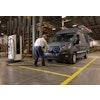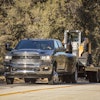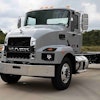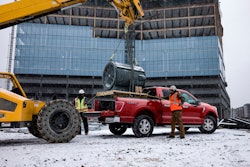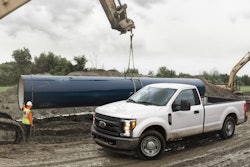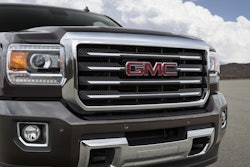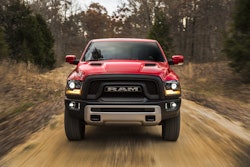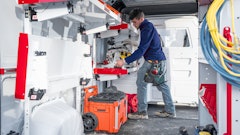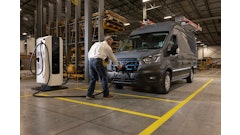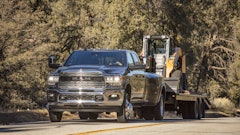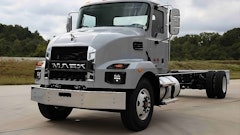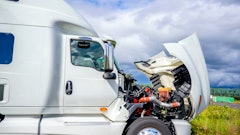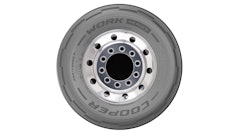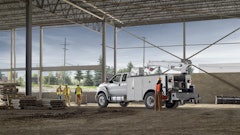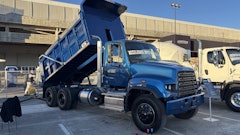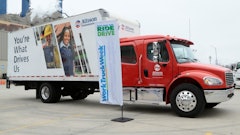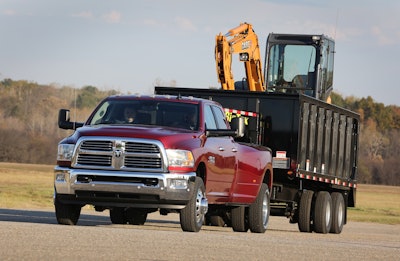
The 2016/2017 pickup trucks usher in advanced technology to supplement the tow/haul modes and integrated trailer brakes that have already become commonplace. Many advancements in this towing gear are built on electronic steering and the growing proliferation of camera technology.
While the technology is being adopted on both full-size light-duty and heavy-duty pickups, most users will benefit from the larger towing capacities of heavy-duty vehicles. “An interesting piece of data as it relates to the 1/2-ton segment: Most customers tow less than 5,000 lbs., if they tow at all,” says Nick Cappa, Ram Truck. “In fact, towing capability does not rank in the top reasons for a purchase. Fuel economy, design and features rank much higher.”
The dynamics of the full-size light-duty pickup market have been evolving. “The 1/2-ton pickup truck segment has evolved from brute capability and acceptable efficiency to an engineering and execution that combine desirable size, configurations, capability, refinement, technology and quality — and now, most importantly, outstanding fuel efficiency,” says Cappa.
The emphasis on towing capability steps up dramatically in significance as pickups increase in size. “Moving into the heavy-duty segments, the demand curve for capability goes straight up,” says Cappa. “Customers rank capability as No. 1 by a landslide. More than 20% of ‘why buys’ are related to towing or hauling in the 3/4- and 1-ton segments.”
Light-duty Towing Aides Instill Confidence
While towing may not be the main focus of the full-size light-duty pickups, it doesn’t mean manufacturers have ignored towing capability. In fact, the growing suite of electronic towing aides instills confidence in both inexperienced and experienced drivers.
Consider the 2016 Ford F-150. It offers a Pro Trailer Backup Assist that helps make backing up a trailer as easy as turning a knob. “Pro Trailer Backup Assist came from us having electronic steering on the F-150,” says Brad Hochrein, chassis control supervisor, Ford Motor Company. “It is a great feature for both novice and experienced customers. We wanted to help them back up trailers, take over some of the steering and help them move a trailer in a parking lot.”
The knob on the Pro Trailer Backup Assist controls steering and limits vehicle speed. “By using the reverse camera to watch the trailer, the driver takes their hands off the steering wheel and simply turns the knob left or right,” Hochrein explains. “The truck steers itself, placing the trailer where you want to go. The result is less time to back up a trailer with improved confidence. It even helps experienced trailer towers to back a trailer faster.”
This technology is combined with:
- a 360°camera with split view that is helpful when maneuvering in tight spaces;
- smart trailer towing connector that informs you of trailer connectivity issues (such as burned out trailer marker or brake lamps);
- Dynamic Hitch Assist that provides a line-of-sight to help direct you to the trailer hitch ball; and
- AdvanceTrac electronic stability control with Trailer Sway Control.
Similar to other competitors, Ford also offers tow/haul mode and an integrated trailer brake controller on its light-duty pickups.
General Motors’ Chevrolet Silverado 1500 and GMC Sierra 1500 are introducing electric variable-assist power steering as standard on all models. It reduces steering effort at low speeds. Because there is no engine-driven pump, electric steering also saves fuel and eliminates the maintenance associated with hydraulic power steering.
The light-duty Chevrolet and GMC models also offer a suite of features to simplify towing. They include StabiliTrak electronic stability control, trailer sway control, an integrated trailer brake and hill start assist.
StabiliTrak is standard on all Chevrolet Silverado and GMC Sierra 1500 models. It works in concert with the four-wheel disc brake system and four-channel ABS to provide more precise and controlled ABS stops, greater traction and cornering stability. It also incorporates rollover mitigation technology, which anticipates tip-up conditions, such as fishtailing on a flat road surface and rapidly applies brake pressure to help reduce the likelihood of a rollover.
Trailer sway control is standard and works with StabiliTrak to provide an added measure of confidence when towing a trailer. It senses conditions of trailer sway and, without input from the driver, intervenes with braking and/or reduces engine power to bring the trailer under control and keep it on its intended path. The system will use electric trailer brakes when a trailer is plugged into the standard wiring harness.
Ram 1500 light-duty pickups feature an air suspension system to increase towing capability. The Active-Level Four-Corner Air Suspension offers automatic load leveling and five ride height settings to improve capability and efficiency. Two selectable positions allow the driver maximum clearance control from the dashboard. This smart suspension also automatically lowers the truck at highway speeds to reduce drag.
A customizable multi-view dial cluster with a 7-in. color display gauge allows you to view vital vehicle data such as temperature settings, fuel economy, trip info, cruise control, trailer braking, vehicle status and engine performance. A “roller menu” provides access via a toggle on the steering wheel. The display allows you to customize vehicle information to your needs.
Ram trucks also utilize the latest camera technology. A rear camera off the tailgate allows for easy TAG connection. The available ParkView Rear Back-Up Camera provides a clear view out back in the rearview mirror. When equipped with the 5- or 8.4-in. Uconnect multi-media center, the image is displayed on the touchscreen and provides dynamic grid lines to help steer you safely into position.
The integrated trailer brake on Ram 1500s simplifies towing by storing multiple trailers in its memory. This includes brake settings and the miles on the trailer for maintenance tracking.
Standard on every Ram 1500, electronic stability control (ESC) reduces engine power and applies individual brakes as needed when it senses a loss of traction or control. ESC works with multiple advanced technologies including Ready Alert Braking, All-Speed Traction Control, Hill Start Assist and Trailer Sway Control.
Another technology that makes pulling a trailer a little easier is Hill Start Assist, which automatically stops the vehicle from rolling backward if you take your foot off the brake while stopped on an incline. Hill Start Assist disengages when acceleration resumes.
Heavy-duty Technology
With the majority of heavy-duty trucks used for towing, manufacturers have stepped to the plate with technical innovations. Many of them focus on visibility, which is key to safe towing.
Ford’s larger 2017 Super Duty pickups include new features and up to seven cameras to enhance towing performance. Advanced coaching and camera technology makes conventional and gooseneck/fifth-wheel towing easier and more efficient. The cameras help customers see more angles and monitor conditions around the truck to aide towing.
A center high-mounted stop lamp camera provides visibility into the cargo box, allowing for easier hook-up of gooseneck/fifth-wheel trailers. A 360° camera system uses four digital, high-definition cameras to give the driver a bird’s-eye view around the truck. Trailer reverse guidance provides visual cues and tips to help with backing a trailer. A factory available camera can be attached to a trailer to improve visibility while backing.
But increased visibility extends beyond camera technology. A Blind Spot Information System (BLIS) with trailer tow is optimized for the Super Duty to include the length of the trailer. BLIS uses radar sensors in the tail lamps to monitor areas that may not be visible to the driver.
To keep an eye on trailer tire pressures, the Super Duty pickups offer an in-cab trailer tire pressure monitoring system. In addition, adaptive steering reduces the amount of steering input needed to change direction at low speed, while reducing sensitivity to steering input at higher speeds. This helps make towing the heaviest loads easier and brings greater ease when navigating jobsites and parking lots — with or without a trailer.
Steering effort was also a focus at General Motors. For 2016, some Chevrolet and GMC HD trucks feature Digital Steering Assist to complement the existing integrated cruise control, powertrain grade braking and diesel exhaust braking. Digital Steering Assist power steering on some double cab and crew cab models offers electronic controls that enhance road holding and stability on the highway (particularly on crowned roads) regardless of whether the truck is loaded. It promises greater responsiveness and an improved steering feel, as well.
The Digital Steering Assist system continuously adjusts the amount of hydraulic assist provided to the driver while steering. It’s similar in concept to electric power steering, where a continuous and varied amount of steering motor torque is used to assist the driver. However, Digital Steering Assist uses hydraulics as the primary power source.
Compared to a conventional passive hydraulic system, Digital Steering Assist reduces the amount of work and attention the driver exerts to steer and control the truck. As a result, the truck feels more controlled, with stability at higher speeds and on surfaces such as crowned roads. Additional features include:
- Speed-variable assist — Lighter turning effort at lower speeds provides easier maneuverability in parking lots and heavier effort at higher speeds, enhancing directional control.
- Returnability assist — This improves the steering wheel return to center after low-speed parking maneuvers.
- Pull compensation — This feature recognizes when a hydraulic pressure offset is required while driving on a sloped road, reducing the driver’s need for steering input. The truck drives straighter and the driver is less fatigued.
- Improved Tow/Haul mode efforts — Similar to speed variable assist, when the vehicle is in Tow/Haul mode, less effort is required for parking, making it easier to maneuver a trailer. A heavier effort at higher speeds helps provide a greater feeling of control and stability.
Ram Truck rises to the occasion with air suspension options on the 2500 and 3500 pickups. A benefit to the air suspension design is the load-leveling capability, which automatically detects load on the rear suspension from a trailer or payload. The air pressure increases until the vehicle reaches normal ride height, leveling the truck and improving stability and loaded ride. On the 2500, an air bag replaces the coil spring, while the 3500 offers a supplemental air bag suspension option.
A Configurable Electronic Vehicle Information Center with an available 7-in. multi-view cluster display provides a selection of trailer towing focused gauges, including trailer brake gain, transmission temperatures and diesel exhaust braking. The main display can also display oil life, fuel filter life, turbocharger boost pressure, tire pressures, engine hours, trailer hours and a range of powertrain data.
The available ParkView Rear Back Up Camera is mounted within the tailgate handle to provide the driver with a clear view of what’s behind the vehicle. The color dashboard display helps simplify parking and trailer hookups. A cargo-view camera, mounted in the center high-mounted stop lamp, provides a view of the bed for easier fifth-wheel or gooseneck trailer hookup, as well as for monitoring bed loads.
The 2016 Ram Heavy Duty pickup allows users to switch the view of the Uconnect 8.4-in. screen from backup camera to cargo view with the touch of the screen. A new bed lighting system uses bright LEDs mounted in the rear corners of the bed for better visibility when working late hours; using the cargo-view camera; or connecting/disconnecting trailers.
The available dashboard-mounted trailer brake controller on the center console allows the user to automatically or manually operate the electronic brakes on properly equipped trailers. The Uconnect system can store different trailers in memory, including settings for brake controller, miles for maintenance and more.
While key performance characteristics such as horsepower, torque and available gear ratios still dominate towing capability specs, the advent of advanced towing technology also deserves close attention. These technologies can instill confidence, reduce the driver’s workload and provide an additional measure of safety — all of which are critical when pulling heavy loads.

